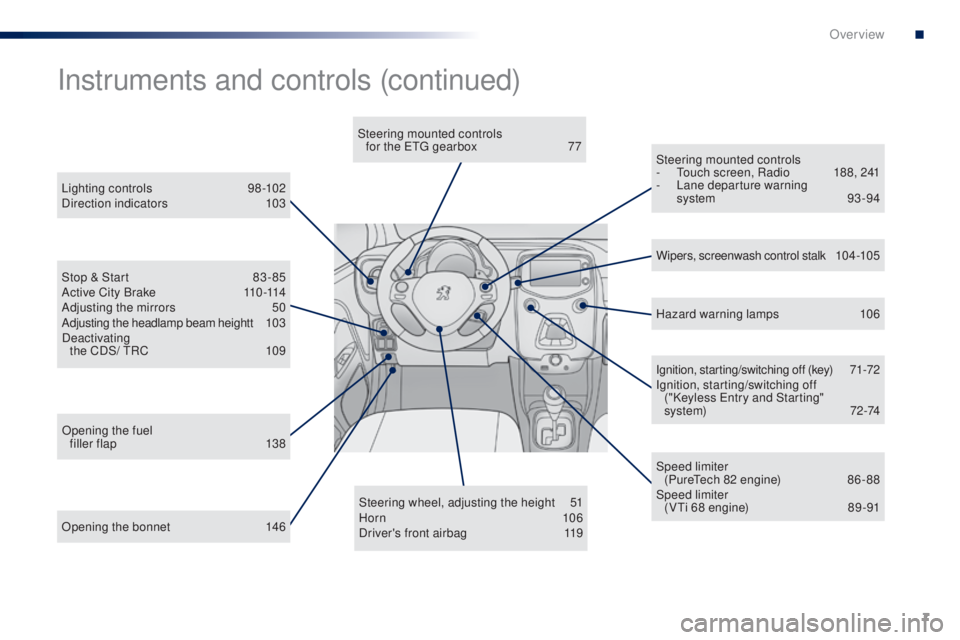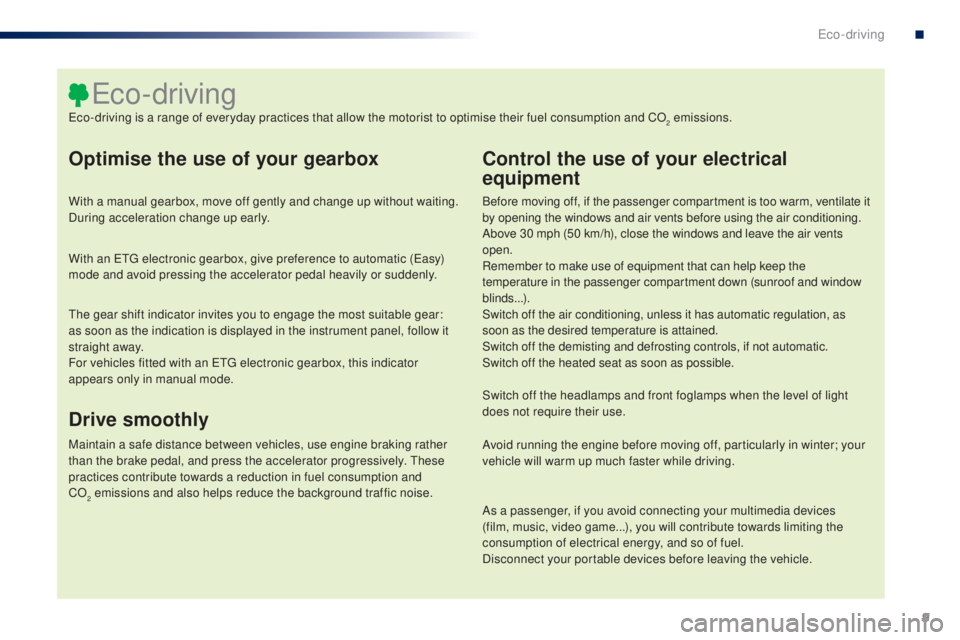2016 PEUGEOT 108 fuel
[x] Cancel search: fuelPage 5 of 268

.
108_en_Chap00a_sommaire_ed01-2016
exterior lighting control stalk 98
Automatic illumination of headlamps
1
01
Direction indicators
1
03
Headlamp beam height adjustment
1
03
Wiper control stalk
1
04
Lighting and visibility
Horn 10 6
Hazard warning lamps
1
06
e
SC system
1
07
Active City Brake
1
10
Seat belts
1
15
Airbags
118
Child seats
1
23
Deactivating the passenger's front airbag
1
26
ISOFIX child seats
1
32
Child lock
1
37
SafetyIn the event of a breakdown
Fuel tank 1 38
Snow chains
1
40
el
ectrical energy economy mode
1
41
Accessories
142
Changing a wiper blade
1
44
Fitting roof bars
1
44
Bonnet
14
6
Petrol engines
1
47
Checking levels
1
48
C h e c ks
151
Practical informationte chnical data
7-inch touch screen 185
Radio
2
35
Audio equipment and telematics
Alphabetical index
temporary puncture repair kit 1 53
Spare wheel
1
58
Changing a bulb
1
63
Changing a fuse
1
68
12 V battery
1
77
to
wing the vehicle
1
80
en
gines
181
Weights
182
Dimensions
183
Identification markings
1
84
Contents
Page 6 of 268

4
108_en_Chap00b_vue-ensemble_ed01-2016
Keys 31
Remote control 3 2-33
"Keyless
e
n
try and Starting"
system
34-37
Remote control battery
3
3, 37
Starting
7
1, 72-73
exterior
Door mirrors 5 0
Lighting control stalk
9
8 -103
Adjusting the headlamps
1
03
Changing bulbs
1
63-165, 167
-
f
ront lamps
-
d
irection indicator repeaters
Doors
38-40
-
ope
ning / closing
-
c
entral locking
el
ectric windows
4
1
Quarter lights (5 -door)
4
1 Wipers
10
4 -105
Changing a wiper blade
1
44
Boot 39-40te
mporary puncture
repair kit
1
53-157
Reversing camera
9
2
to
w i n g
18 0
Changing bulbs
1
66-167
-
r
ear lamps
-
3
rd brake lamp
-
n
umber plate lamps
Fuel tank, ref uelling
13 8 -13 9
Fuel gauge
26
ele
ctronic stability
programme
107-109
Snow chains
1
40
un
der-inflation detection
9
5-97
ty
re pressures
1
56 -157, 184
Changing a wheel
1
58-162
-
tools
-
r
emoval / fitting
ele
ctric fabric roof
4
2-45
Roof bars
1
44
Accessories
1
42-143
Over view
Page 9 of 268

7
108_en_Chap00b_vue-ensemble_ed01-2016
Opening the bonnet 146Steering wheel, adjusting the height
5
1
Horn 10 6
Driver's front airbag 1 19Ignition, starting/switching off (key)
7
1-72
Ignition, starting/switching off ("Keyless e
n
try and Starting"
system)
7
2-74
Steering mounted controls
- t
o
uch screen, Radio
1
88, 241
-
L
ane departure warning
system 93 -94
Instruments and controls (continued)
Lighting controls 9
8-102
Direction indicators 1 03
Stop & Start
8
3 - 85
Active City Brake
1
10 -114
Adjusting the mirrors
5
0
Adjusting the headlamp beam heightt
1
03
Deactivating the CDS/
t
R
C
1
09 Wipers, screenwash control stalk
1
0 4 -10 5
Speed limiter (Pure
te
ch 82 engine)
8
6 - 88
Speed limiter (V
ti 6
8 engine)
8
9 -91
Opening the fuel
filler flap
1
38 Hazard warning lamps
1
06
Steering mounted controls
for the etg gearbox
7
7
.
Over view
Page 11 of 268

9
108_en_Chap00c_eco-conduite_ed01-2016
optimise the use of your gearbox
With a manual gearbox, move off gently and change up without waiting.
During acceleration change up early.
With an etg electronic gearbox, give preference to automatic (
ea
sy)
mode and avoid pressing the accelerator pedal heavily or suddenly.
Control the use of your electrical
equipment
Before moving off, if the passenger compartment is too warm, ventilate it
by opening the windows and air vents before using the air conditioning.
Above 30 mph (50 km/h), close the windows and leave the air vents
open.
Remember to make use of equipment that can help keep the
temperature in the passenger compartment down (sunroof and window
blinds...).
Switch off the air conditioning, unless it has automatic regulation, as
soon as the desired temperature is attained.
Switch off the demisting and defrosting controls, if not automatic.
Switch off the heated seat as soon as possible.
Switch off the headlamps and front foglamps when the level of light
does not require their use.
Avoid running the engine before moving off, particularly in winter; your
vehicle will warm up much faster while driving.
As a passenger, if you avoid connecting your multimedia devices
(film, music, video game...), you will contribute towards limiting the
consumption of electrical energy, and so of fuel.
Disconnect your portable devices before leaving the vehicle.
eco-driving
eco-driving is a range of everyday practices that allow the motorist to optimise their fuel consumption and CO2 emissions.
th
e gear shift indicator invites you to engage the most suitable gear:
as soon as the indication is displayed in the instrument panel, follow it
straight away.
For vehicles fitted with an
etg
electronic gearbox, this indicator
appears only in manual mode.
Drive smoothly
Maintain a safe distance between vehicles, use engine braking rather
than the brake pedal, and press the accelerator progressively. th ese
practices contribute towards a reduction in fuel consumption and
CO
2 emissions and also helps reduce the background traffic noise.
.
eco-driving
Page 12 of 268

10
108_en_Chap00c_eco-conduite_ed01-2016
Limit the causes of excess consumption
Spread loads throughout the vehicle; place the heaviest items in the
bottom of the boot, as close as possible to the rear seats.
Limit the loads carried in the vehicle and reduce wind resistance
(roof bars, roof rack...). u
s
e a roof box in preference.
Remove roof bars and roof racks after use.
At the end of winter, remove snow tyres and refit your summer tyres.
observe the recommendations on
maintenance
Check the tyre pressures regularly, when cold, referring to the label in
the door aperture, driver's side.
Carry out this check in particular:
-
b
efore a long journey,
-
a
t each change of season,
-
a
fter a long period out of use.
Don't forget the spare wheel and the tyres on any trailer or caravan.
Have your vehicle serviced regularly (engine oil, oil filter, air filter,
passenger compartment filter...) and observe the schedule of
operations recommended in the warranty and maintenance record.
When refuelling, do not continue after the third cut-off of the nozzle to
avoid any over flow.
At the wheel of your new vehicle, it is only after the first 1 800 miles
(3
000 kilometres) that you will see the fuel consumption settle down to
a consistent average.
eco-driving
Page 19 of 268

17
108 _en_Chap01_instrument- de-bord_ed01-2016
Low fuel levelfixed, accompanied by
an audible signal. When it first comes on there remains
approximately 5 litres of fuel
in the
tank. You must refuel as soon as possible to avoid running
out of fuel.
th
is warning lamp will come on every time the ignition
is switched on, until a sufficient addition of fuel is
made.
Fuel tank capacity: approximately 35 litres.
Never continue to drive until you run out of fuel as
this could damage the emission control and injection
systems.
Battery charge fixed.
th
e battery charging circuit has a
fault (dirty or loose terminals, slack or
cut alternator belt, ...). Contact a P
e
uge
Ot
dealer or a qualified workshop.
em
ission control
system fixed.
th
e emission control system has a
fault. Contact a P
e
uge
Ot
dealer or a qualified workshop
without delay.
en
gine fault
fixed. A major fault has been detected that
does not have a specific warning lamp. You must contact a P
e
uge
Ot
dealer or a qualified
workshop.
Dynamic
stability control
and traction
control (DSC/
tR
C)
flashing.
th
e DSC/
tR
C system is in action.
th
e system optimises traction and improves the
directional stability of the vehicle.
fixed.
th
e DSC/
tR
C system has a fault. Have it checked by a P
e
uge
Ot
dealer or a qualified
workshop.
Warning / indicator lamp
StateCause Action / o
b
servations
1
Instruments
Page 28 of 268

26
Indicators
total/trip distance
recorder
Press one of the buttons 1 to alternate the
distance display:
-
t
otal with " o
D
o
" (
odometer) displayed,
-
t
rip with "
t
RIP" displayed.
to r
eset the trip recorder to zero, when
it is displayed, press and hold one of the
two
buttons 1 .
When the ignition is switched on, the distance
recorder selected when the engine was
switched off is displayed.th
is indicates the quantity of fuel available:
- 1/ 1 and six bars, the fuel tank is full.
-
R
and one bar, the fuel tank is on the
reserve.
Low fuel level
Fuel gauge
At least 5 litres must be added after
running out of fuel.
You have approximately 5 litres remaining.
When the low level in the fuel tank is
reached, this warning lamp comes on
in the instrument panel, accompanied
by an audible signal.
Instruments
Page 29 of 268

27
108 _en_Chap01_instrument- de-bord_ed01-2016
tr i p c o m p u t e r
System that gives you information on the journey in progress (range, fuel consumption…).
Information display
F Press one of theses buttons to display the various trip computer tabs in turn:
-
t
h
e total distance.
-
t
h
e trip "A".
-
t
h
e trip "B" .
-
t
h
e Stop & Start partial time counter*.
-
t
h
e Stop & Start global time counter*.
-
t
h
e ambient temperature*.
-
t
h
e current fuel consumption.
-
t
h
e average fuel consumption.
-
t
he
remaining range.
-
t
h
e average speed.
-
t
h
e lighting dimmer.
trip reset
F When the trip required is displayed, press one of the two " DISP" buttons for more
than two seconds.
t
r i p s "A" and "B" are independent but their
use is identical.
For example, trip "A" can be used for daily
figures, and trip "B" for monthly figures.
* Depending on version.
Ambient temperature
In certain situations, the ambient temperature
may only be displayed after a delay or not at all, in
particular:
- when stationary or at low speed (less than about 18 mph (25 km/h),
- where there is too much variation in temperature (entering or leaving a garage, a tunnel...),
- during very short journeys (less than about 2 minutes).
Lighting dimmer
When driving at night, this function allows
certain displays in the instrument panel to be
switched off to reduce visual fatigue for the
driver.
It operates only when the sidelamps are on.
F
W
hen the "Lighting dimmer" menu
is displayed, press and hold one of
the " DISP " buttons for access to the
adjustment.
F
t
h
en make repeated presses on one of the
two " DISP " buttons to increase or reduce
the brightness.
t
h
e display flashes to show you the
brightness chosen.
1
Instruments